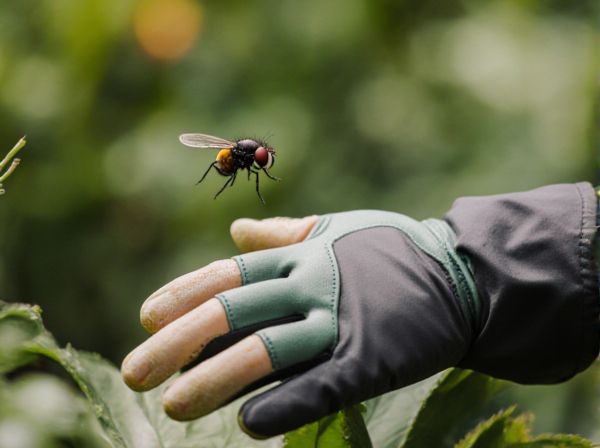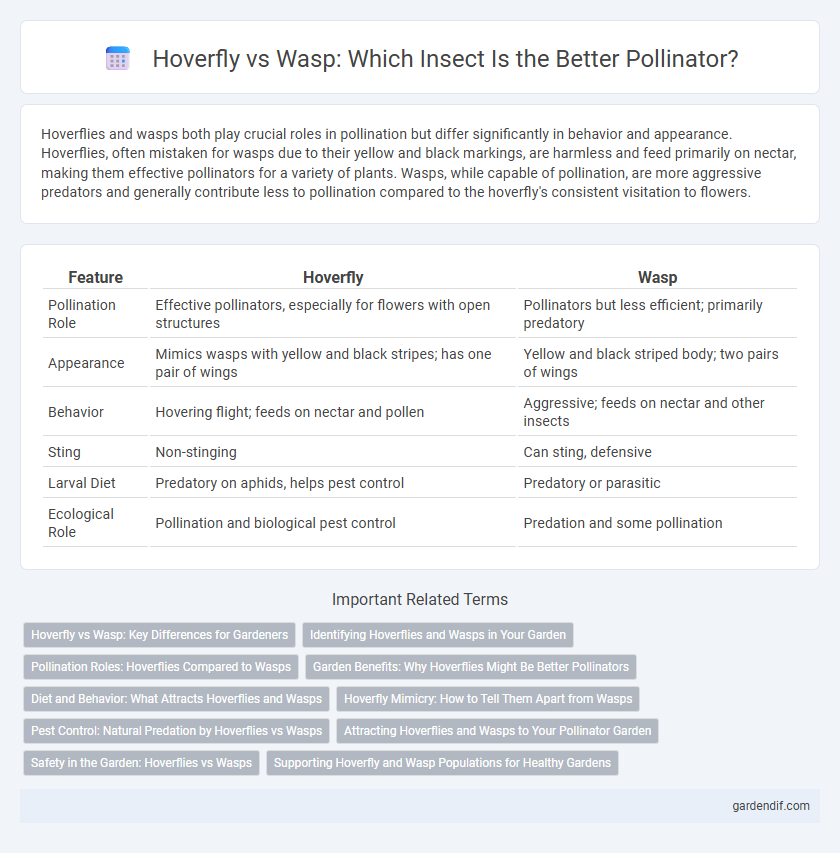
Hoverfly vs Wasp Illustration
Hoverflies and wasps both play crucial roles in pollination but differ significantly in behavior and appearance. Hoverflies, often mistaken for wasps due to their yellow and black markings, are harmless and feed primarily on nectar, making them effective pollinators for a variety of plants. Wasps, while capable of pollination, are more aggressive predators and generally contribute less to pollination compared to the hoverfly's consistent visitation to flowers.
Table of Comparison
| Feature | Hoverfly | Wasp |
|---|---|---|
| Pollination Role | Effective pollinators, especially for flowers with open structures | Pollinators but less efficient; primarily predatory |
| Appearance | Mimics wasps with yellow and black stripes; has one pair of wings | Yellow and black striped body; two pairs of wings |
| Behavior | Hovering flight; feeds on nectar and pollen | Aggressive; feeds on nectar and other insects |
| Sting | Non-stinging | Can sting, defensive |
| Larval Diet | Predatory on aphids, helps pest control | Predatory or parasitic |
| Ecological Role | Pollination and biological pest control | Predation and some pollination |
Hoverfly vs Wasp: Key Differences for Gardeners
Hoverflies resemble wasps but lack stingers, making them safe pollinators in gardens. Their larvae target aphids, providing natural pest control, while wasps can be aggressive and pose risks to humans. Gardeners benefit from encouraging hoverflies to enhance pollination and reduce harmful insect populations without the danger associated with wasps.
Identifying Hoverflies and Wasps in Your Garden
Hoverflies can be identified by their large, compound eyes, short antennae, and characteristic hovering flight pattern, often mimicking wasps with their yellow and black striped bodies but lacking a narrow waist. Wasps have a more segmented body with a distinct constriction between the thorax and abdomen, longer antennae, and typically exhibit more aggressive behavior compared to hoverflies. Recognizing these differences in your garden helps distinguish beneficial pollinating hoverflies from wasps, which are less effective pollinators and can be more defensive.
Pollination Roles: Hoverflies Compared to Wasps
Hoverflies play a crucial role in pollination by frequently visiting flowers and transferring pollen, often more efficiently than wasps, which tend to focus more on predation than nectar gathering. Hoverflies possess adaptations such as hairy bodies that collect and distribute pollen, making them important pollinators in both agricultural and natural ecosystems. Wasps contribute to pollination but generally to a lesser extent, as their primary diet and behavior reduce their pollen transfer efficiency compared to hoverflies.
Garden Benefits: Why Hoverflies Might Be Better Pollinators
Hoverflies contribute significantly to garden health by efficiently pollinating a wide variety of flowers while posing no threat to humans, unlike wasps which can sting and may disrupt outdoor activities. Their larvae consume aphids, providing natural pest control that supports plant growth and reduces the need for chemical pesticides. Hoverflies are active in cooler and shaded environments where many wasps are less effective, extending the pollination period and promoting biodiversity in gardens.
Diet and Behavior: What Attracts Hoverflies and Wasps
Hoverflies are attracted to flowers rich in nectar and pollen, serving as important pollinators with larvae often feeding on aphids, while wasps are primarily drawn to sugary substances and protein sources, including other insects, as their diet supports both adult and larval stages. Hoverflies exhibit hovering flight near flowers and play a key role in pollination, whereas wasps display more aggressive behavior for defending territory and hunting prey. Understanding these dietary preferences and behaviors highlights the ecological roles of hoverflies as beneficial pollinators and wasps as both pollinators and pest controllers.
Hoverfly Mimicry: How to Tell Them Apart from Wasps
Hoverflies exhibit remarkable mimicry of wasps by displaying similar black and yellow banding, yet their behavior and physical traits help distinguish them; hoverflies have large, single pair wings while wasps possess two pairs, and hoverflies often hover in place, unlike the more aggressive flight of wasps. Their eyes cover most of the head, and they lack the narrow waist characteristic of wasps, making these features key identifiers. Understanding hoverfly mimicry aids in recognizing their role as beneficial pollinators rather than potential threats.
Pest Control: Natural Predation by Hoverflies vs Wasps
Hoverflies act as natural pest controllers by consuming aphids and other soft-bodied insects during their larval stage, reducing the need for chemical pesticides. Wasps also contribute to pest control by preying on a variety of garden insects, including caterpillars and beetle larvae, enhancing ecosystem balance. Both insects provide essential services in integrated pest management, with hoverflies being especially beneficial due to their pollination role alongside pest regulation.
Attracting Hoverflies and Wasps to Your Pollinator Garden
Planting a diverse array of nectar-rich flowers such as alyssum, yarrow, and fennel effectively attracts hoverflies, which are beneficial pollinators and natural pest controllers. Wasps are drawn to protein sources like decaying fruit and meat as well as flowering plants such as goldenrod and queen anne's lace that provide nectar. Creating varied habitats with flowering plants and decaying organic matter supports both hoverflies and wasps, enhancing pollination and pest management in your garden.
Safety in the Garden: Hoverflies vs Wasps
Hoverflies pose minimal risk in the garden as they rarely sting and are non-aggressive pollinators, making them safer around children and pets. Wasps can defend their nests aggressively, delivering painful stings that may cause allergic reactions in sensitive individuals. Choosing hoverflies over wasps enhances garden safety while maintaining effective pollination and pest control.
Supporting Hoverfly and Wasp Populations for Healthy Gardens
Supporting hoverfly and wasp populations enhances pollination efficiency and natural pest control, crucial for healthy gardens. Providing diverse flowering plants ensures continuous nectar sources, while avoiding broad-spectrum insecticides preserves these beneficial insects. Creating habitats with shelter and water access encourages their presence, improving garden biodiversity and resilience.
Hoverfly vs Wasp Infographic

 gardendif.com
gardendif.com